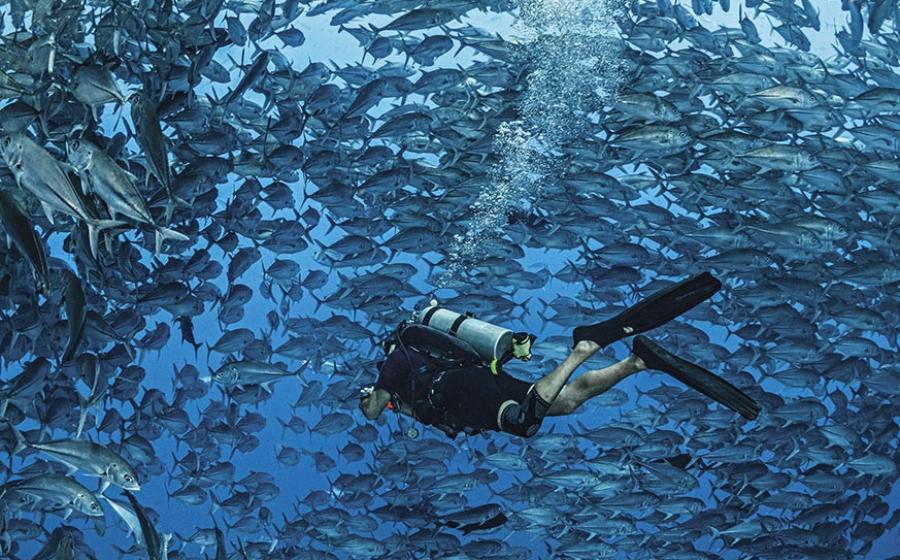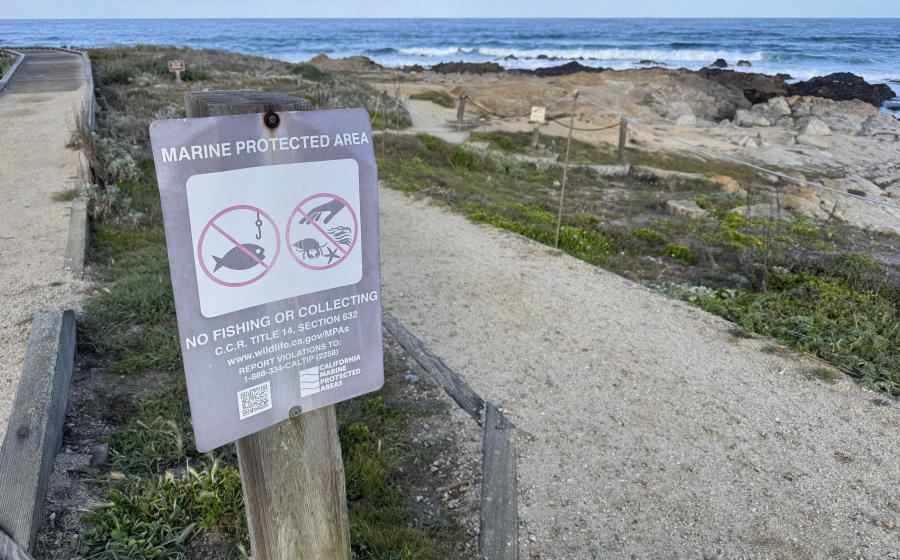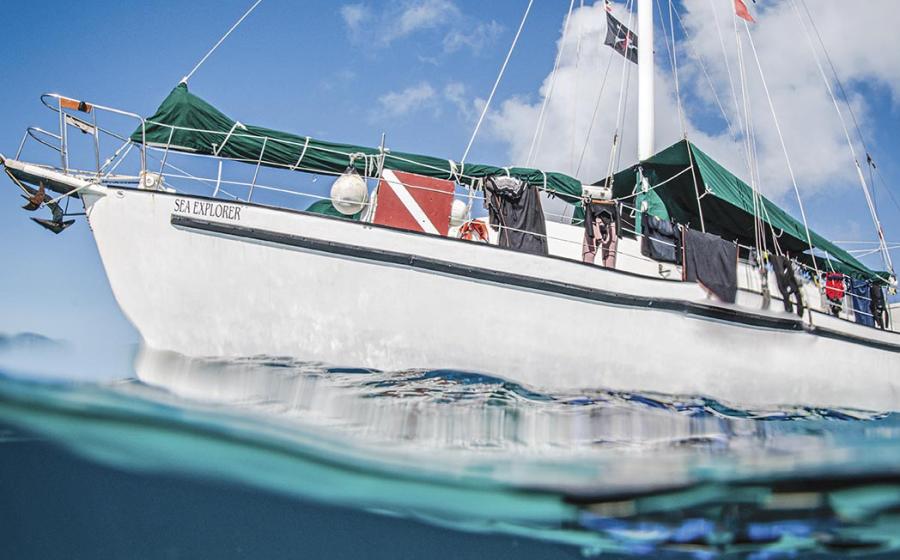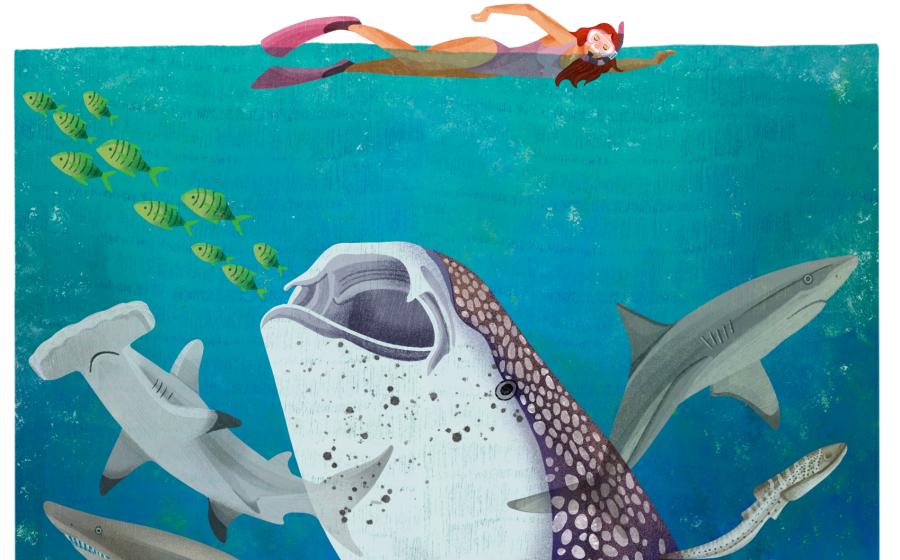Guide to Underwater Imaging
 |
| The Dominican Republic offers clear water, excellent sponge life and a surprising diversity of marine life. |
April 2002
Text and Photography by Stephen Frink
What if you didn't have to worry about money, time, dive infrastructure or, more recently, political turmoil? What if you could go anywhere to indulge your passion for underwater photography? Where would you go? Here are some of my personal favorites:
Australia
An amazing diversity of dive options, from the fascinating temperate waters of Jervis Bay and Kangaroo Island to tropical dives off the Queensland Coast and along the Great Barrier Reef. Australia is a long and expensive trip for North American divers, so choose carefully what part of the continent to dive. I like South Australia (off Port Lincoln) for white sharks and Australian sea lions, Western Australia for the seasonal whale shark migration, and the Great Barrier Reef for lots of fine diving. The visibility is sometimes challenging, but there are great critters, not to mention the amazing SS Yongala shipwreck. For stunning water clarity, often in excess of 200 feet, opt for a live-aboard to the Coral Sea.
Bahamas
There is no more eclectic, and often electric, dive destination in the Western Hemisphere than the Bahamas. Of course there are the iconic sites such as the shark dives off New Providence and Freeport. But there are also the wild spotted dolphins off West End Grand Bahama and near Bimini; vertical walls along the Tongue of the Ocean, exciting drift dives in the Exumas, and both modern and historical shipwrecks everywhere. With 700 islands and thousands of miles of crystalline ocean, the Bahamas are a photographer's dream destination. Plus, they are close to the U.S. and reasonably priced.
Bay Islands
The Bay Islands of Honduras offer attractions off each major island. The Jado Trader shipwreck and the mass of fish that swarm Jim's Silverlode are the big attractions on Guanaja, while macro enthusiasts will find the Cayos Cochinos extremely productive. Utila provides frequent whale shark encounters, as well as excellent reef and seamount diving. Roatan offers the bottlenose dolphins at Anthony's Key Resort, a lovely coral reef, and marine life accustomed to divers and therefore approachable.
Belize
Three atolls and a massive barrier reef define the underwater portfolio here. When I first visited Belize two decades ago, I found the laid-back ambience of San Pedro on Ambergris Caye charming, but the marine life sparse. Now, years of marine conservation (driven specifically by dive tourism) surrounding the Hol Chan preserve has replenished fish stocks and added new zest to the photographic appeal. Offshore, the big attractions are the wide-angle potential of Lighthouse Reef and the abundant marine life of the Turneffe Islands.
Bermuda
While there is some coral reef and interesting marine life off Bermuda, to me the prime photo attraction is the wealth of historical shipwrecks run aground here. There are more than 400 identified wrecks here, spanning the last 500 years. A few have been sunk recently as dive attractions, but most got there the old-fashioned way--mariners' mistakes, storms and bad luck.
Bonaire
If ever there were an island designed for diving (and underwater photography) it's Bonaire. With stunning coral reefs along the leeward side of the island and Klein Bonaire, this is easy, productive diving any time of year. The water is warm and clear, the hotels and dive operators absolutely top-notch, and the photographic potential for small fish and macro life is extraordinary. If you want sharks and big critters, Bonaire is not the best choice. But for an easy scuba holiday with dive operators eager to please, Bonaire is one of the best.
Cayman Islands
This is the Big Kahuna of Caribbean diving, and despite years of popularity, it is still an amazingly productive photo destination. All three Cayman Islands offer terrific water clarity, but there are photo-ops specific to each island. On Grand Cayman there are the famed stingrays of Sandbar and Stingray City, excellent wall diving along the North and South shores, shark dives, tarpon encounters and easy (yet productive) dives along the leeward western coast. Cayman Brac's signature dive is the wreck of the Russian Destroyer (or Keith Tibbetts), excellent reefs and walls. Little Cayman's Bloody Bay Wall is justifiably world-famous. For macro, fish and especially wide-angle photography, the Caymans have it all.
Cocos Island
||
|---|
|  |
|
| The soft corals and massive gorgonians of the Fiji coral reef adds wonderful color accents to the wide-angle view.|
While Cocos Island is not easy to get to, requiring a 36-hour steam by live-aboard from the mainland of Costa Rica, the wealth of dramatic pelagic life seen along these submerged seamounts justifies Cocos on any serious photographer's wish list. Schooling hammerheads, manta rays, marbled rays, Galapagos and silky sharks, turtles and massive schools of jack are commonly seen.
Cozumel
Absolutely stunning water clarity and massive filter feeders, which thrive in the continual currents of Cozumel, make this a destination unlike any other. The fish photography along the shallow reef is excellent, and there are even ample macro subjects for those who can turn away from the big picture long enough to study the reef's minutiae. But this is wide-angle heaven, with strobe fill painting the vibrant oranges, reds and lavenders of a cornucopia of sponge life. Sophisticated dive professionals and an eclectic mix of wonderful resorts add to the appeal.
Dominican Republic
If ever there were a dive destination misunderstood by the traveling underwater photographer, it's the DR. Of course we all know about the seasonal humpback whale migration in the Silver Bank. But what is little known is that the reefs, wrecks and even the caves found in the Bayahibe region are as good as most in the Caribbean, and better than many. Now I didn't say it is good everywhere in the DR, for the diving off Punta Cana is pretty pedestrian. But, if you do your research and know where to go, the DR is a great destination--safe, inexpensive, friendly and diverse.
Fiji
||
|---|
|  |
|
| The Christ of the Abyss is a popular photographic icon for visitors to Key Largo, Fla.|
It's heretical to say, but I've always wondered why so many California divers make their way to the Caribbean when Fiji is just a nine-hour airplane ride away and offers beautiful resorts, good vacation value, and excellent diving. Maybe because Fiji is so massive and diverse it's hard to get a handle on. Soft corals and both big and small critters are a given, yet even after a half-dozen visits to Fiji, I still feel the need to explore more. After all, isn't that thrill of discovery what motivates us all?
Galapagos
Like Cocos, the Galapagos are one of the places to go for big critter encounters. Whale sharks, schooling hammerheads, mobula rays and Galapagos sharks are likely, in addition to the comical underwater antics of sea lions. The Galapagos offer the very big plus of wonderful topside attractions, including marine iguanas, penguins and all manner of sea bird. Several custom dive live-aboards make it possible to take in a wide diversity of island attractions in seven- and 10-day itineraries.
Key Largo, Fla.
This is my hometown, so I'll admit some bias, but the marine life that has evolved from decades of preservation is a big draw for Key Largo. The Duane shipwreck is absolutely world-class, and now that the 512-foot Spiegel Grove is attracting both divers and marine life in abundance, Key Largo is recognized as a wreck diver paradise. With shallow reefs, clear water and abundant marine life, Key Largo is a great photo destination close to home. All right, maybe closer to my home than yours, but it's still in the domestic U.S.
Micronesia
A destination that's hard to define due to its extreme diversity, but one that deserves whatever accolades might be heaped upon it. From the manta rays, sharks and lush hard corals of Yap, to the World War II shipwrecks of Chuuk, to the mask-ripping drift dives and awesome walls of Palau, Micronesia merits the attention and repeat visitation of the underwater photographer.
Papua New Guinea
||
|---|
|  |
|
| Papua New Guinea provides pristine reefs perfect for wide-angle vistas.|
This is the destination that defined muck diving, the art of finding rare and wonderful creatures to photograph where other divers might only find detritus. But Papua New Guinea offers much more than the muck critters of Milne Bay. There are awesome wide-angle scenics in waters along Kavieng, Walindi Bay, Madang and off Rabaul. In addition, there are numerous World War II shipwrecks and fascinating topside cultural diversity amid the offshore islands and the Highlands. This is a long trip for North American divers, but PNG diving consistently ranks among the top five in most underwater shooters' logbooks.
Turks and Caicos
Seasonal migrations of humpback whales, gorgeous shallow walls off Grand Turk, vertigo-inspiring drop-offs along Providenciales and wilderness dives along South Caicos are all elements that inspire the underwater images of the Turks and Caicos islands.
|| |---|
| |
| The Dominican Republic offers clear water, excellent sponge life and a surprising diversity of marine life.|
|
| The Dominican Republic offers clear water, excellent sponge life and a surprising diversity of marine life.|
April 2002
Text and Photography by Stephen Frink
What if you didn't have to worry about money, time, dive infrastructure or, more recently, political turmoil? What if you could go anywhere to indulge your passion for underwater photography? Where would you go? Here are some of my personal favorites:
Australia
An amazing diversity of dive options, from the fascinating temperate waters of Jervis Bay and Kangaroo Island to tropical dives off the Queensland Coast and along the Great Barrier Reef. Australia is a long and expensive trip for North American divers, so choose carefully what part of the continent to dive. I like South Australia (off Port Lincoln) for white sharks and Australian sea lions, Western Australia for the seasonal whale shark migration, and the Great Barrier Reef for lots of fine diving. The visibility is sometimes challenging, but there are great critters, not to mention the amazing SS Yongala shipwreck. For stunning water clarity, often in excess of 200 feet, opt for a live-aboard to the Coral Sea.
Bahamas
There is no more eclectic, and often electric, dive destination in the Western Hemisphere than the Bahamas. Of course there are the iconic sites such as the shark dives off New Providence and Freeport. But there are also the wild spotted dolphins off West End Grand Bahama and near Bimini; vertical walls along the Tongue of the Ocean, exciting drift dives in the Exumas, and both modern and historical shipwrecks everywhere. With 700 islands and thousands of miles of crystalline ocean, the Bahamas are a photographer's dream destination. Plus, they are close to the U.S. and reasonably priced.
Bay Islands
The Bay Islands of Honduras offer attractions off each major island. The Jado Trader shipwreck and the mass of fish that swarm Jim's Silverlode are the big attractions on Guanaja, while macro enthusiasts will find the Cayos Cochinos extremely productive. Utila provides frequent whale shark encounters, as well as excellent reef and seamount diving. Roatan offers the bottlenose dolphins at Anthony's Key Resort, a lovely coral reef, and marine life accustomed to divers and therefore approachable.
Belize
Three atolls and a massive barrier reef define the underwater portfolio here. When I first visited Belize two decades ago, I found the laid-back ambience of San Pedro on Ambergris Caye charming, but the marine life sparse. Now, years of marine conservation (driven specifically by dive tourism) surrounding the Hol Chan preserve has replenished fish stocks and added new zest to the photographic appeal. Offshore, the big attractions are the wide-angle potential of Lighthouse Reef and the abundant marine life of the Turneffe Islands.
Bermuda
While there is some coral reef and interesting marine life off Bermuda, to me the prime photo attraction is the wealth of historical shipwrecks run aground here. There are more than 400 identified wrecks here, spanning the last 500 years. A few have been sunk recently as dive attractions, but most got there the old-fashioned way--mariners' mistakes, storms and bad luck.
Bonaire
If ever there were an island designed for diving (and underwater photography) it's Bonaire. With stunning coral reefs along the leeward side of the island and Klein Bonaire, this is easy, productive diving any time of year. The water is warm and clear, the hotels and dive operators absolutely top-notch, and the photographic potential for small fish and macro life is extraordinary. If you want sharks and big critters, Bonaire is not the best choice. But for an easy scuba holiday with dive operators eager to please, Bonaire is one of the best.
Cayman Islands
This is the Big Kahuna of Caribbean diving, and despite years of popularity, it is still an amazingly productive photo destination. All three Cayman Islands offer terrific water clarity, but there are photo-ops specific to each island. On Grand Cayman there are the famed stingrays of Sandbar and Stingray City, excellent wall diving along the North and South shores, shark dives, tarpon encounters and easy (yet productive) dives along the leeward western coast. Cayman Brac's signature dive is the wreck of the Russian Destroyer (or Keith Tibbetts), excellent reefs and walls. Little Cayman's Bloody Bay Wall is justifiably world-famous. For macro, fish and especially wide-angle photography, the Caymans have it all.
Cocos Island
|| |---|
| |
| The soft corals and massive gorgonians of the Fiji coral reef adds wonderful color accents to the wide-angle view.|
While Cocos Island is not easy to get to, requiring a 36-hour steam by live-aboard from the mainland of Costa Rica, the wealth of dramatic pelagic life seen along these submerged seamounts justifies Cocos on any serious photographer's wish list. Schooling hammerheads, manta rays, marbled rays, Galapagos and silky sharks, turtles and massive schools of jack are commonly seen.
|
| The soft corals and massive gorgonians of the Fiji coral reef adds wonderful color accents to the wide-angle view.|
While Cocos Island is not easy to get to, requiring a 36-hour steam by live-aboard from the mainland of Costa Rica, the wealth of dramatic pelagic life seen along these submerged seamounts justifies Cocos on any serious photographer's wish list. Schooling hammerheads, manta rays, marbled rays, Galapagos and silky sharks, turtles and massive schools of jack are commonly seen.
Cozumel
Absolutely stunning water clarity and massive filter feeders, which thrive in the continual currents of Cozumel, make this a destination unlike any other. The fish photography along the shallow reef is excellent, and there are even ample macro subjects for those who can turn away from the big picture long enough to study the reef's minutiae. But this is wide-angle heaven, with strobe fill painting the vibrant oranges, reds and lavenders of a cornucopia of sponge life. Sophisticated dive professionals and an eclectic mix of wonderful resorts add to the appeal.
Dominican Republic
If ever there were a dive destination misunderstood by the traveling underwater photographer, it's the DR. Of course we all know about the seasonal humpback whale migration in the Silver Bank. But what is little known is that the reefs, wrecks and even the caves found in the Bayahibe region are as good as most in the Caribbean, and better than many. Now I didn't say it is good everywhere in the DR, for the diving off Punta Cana is pretty pedestrian. But, if you do your research and know where to go, the DR is a great destination--safe, inexpensive, friendly and diverse.
Fiji
|| |---|
| |
| The Christ of the Abyss is a popular photographic icon for visitors to Key Largo, Fla.|
It's heretical to say, but I've always wondered why so many California divers make their way to the Caribbean when Fiji is just a nine-hour airplane ride away and offers beautiful resorts, good vacation value, and excellent diving. Maybe because Fiji is so massive and diverse it's hard to get a handle on. Soft corals and both big and small critters are a given, yet even after a half-dozen visits to Fiji, I still feel the need to explore more. After all, isn't that thrill of discovery what motivates us all?
|
| The Christ of the Abyss is a popular photographic icon for visitors to Key Largo, Fla.|
It's heretical to say, but I've always wondered why so many California divers make their way to the Caribbean when Fiji is just a nine-hour airplane ride away and offers beautiful resorts, good vacation value, and excellent diving. Maybe because Fiji is so massive and diverse it's hard to get a handle on. Soft corals and both big and small critters are a given, yet even after a half-dozen visits to Fiji, I still feel the need to explore more. After all, isn't that thrill of discovery what motivates us all?
Galapagos
Like Cocos, the Galapagos are one of the places to go for big critter encounters. Whale sharks, schooling hammerheads, mobula rays and Galapagos sharks are likely, in addition to the comical underwater antics of sea lions. The Galapagos offer the very big plus of wonderful topside attractions, including marine iguanas, penguins and all manner of sea bird. Several custom dive live-aboards make it possible to take in a wide diversity of island attractions in seven- and 10-day itineraries.
Key Largo, Fla.
This is my hometown, so I'll admit some bias, but the marine life that has evolved from decades of preservation is a big draw for Key Largo. The Duane shipwreck is absolutely world-class, and now that the 512-foot Spiegel Grove is attracting both divers and marine life in abundance, Key Largo is recognized as a wreck diver paradise. With shallow reefs, clear water and abundant marine life, Key Largo is a great photo destination close to home. All right, maybe closer to my home than yours, but it's still in the domestic U.S.
Micronesia
A destination that's hard to define due to its extreme diversity, but one that deserves whatever accolades might be heaped upon it. From the manta rays, sharks and lush hard corals of Yap, to the World War II shipwrecks of Chuuk, to the mask-ripping drift dives and awesome walls of Palau, Micronesia merits the attention and repeat visitation of the underwater photographer.
Papua New Guinea
|| |---|
| |
| Papua New Guinea provides pristine reefs perfect for wide-angle vistas.|
This is the destination that defined muck diving, the art of finding rare and wonderful creatures to photograph where other divers might only find detritus. But Papua New Guinea offers much more than the muck critters of Milne Bay. There are awesome wide-angle scenics in waters along Kavieng, Walindi Bay, Madang and off Rabaul. In addition, there are numerous World War II shipwrecks and fascinating topside cultural diversity amid the offshore islands and the Highlands. This is a long trip for North American divers, but PNG diving consistently ranks among the top five in most underwater shooters' logbooks.
|
| Papua New Guinea provides pristine reefs perfect for wide-angle vistas.|
This is the destination that defined muck diving, the art of finding rare and wonderful creatures to photograph where other divers might only find detritus. But Papua New Guinea offers much more than the muck critters of Milne Bay. There are awesome wide-angle scenics in waters along Kavieng, Walindi Bay, Madang and off Rabaul. In addition, there are numerous World War II shipwrecks and fascinating topside cultural diversity amid the offshore islands and the Highlands. This is a long trip for North American divers, but PNG diving consistently ranks among the top five in most underwater shooters' logbooks.
Turks and Caicos
Seasonal migrations of humpback whales, gorgeous shallow walls off Grand Turk, vertigo-inspiring drop-offs along Providenciales and wilderness dives along South Caicos are all elements that inspire the underwater images of the Turks and Caicos islands.






